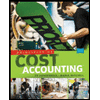
1.
Calculate the break-even point in sales units for the overall Product E for the current year.
1.
Explanation of Solution
Sales mix: It refers to the relative distribution of the total sales among the number of products sold by a company. In other words, it is expressed as a percentage of units sold for each product with respect to the total units sold for all the products.
Break-even Point: It refers to a point in the level of operations at which a company experiences its revenues generated is equal to its costs incurred. Thus, when a company reaches at its break-even point, it reports neither an income nor a loss from operations. The formula to calculate the break-even point in sales units is as follows:
Determine the break-even point in sales units for the overall Product E.
Fixed cost =$2,498,600
Contribution margin per unit =$620 per unit (3)
Note: For break-even analysis, the Product-Laptops and Product-Tablets are considered as the components of one overall company’s Product E.
Working note (1):
Determine the selling price per unit of Product E.
Working note (2):
Determine the variable cost per unit of Product E.
Working note (3):
Determine the unit contribution margin of Product E.
Therefore, the break-even point in sales units for the overall Product E for the current year is 4,030 units.
2.
Calculate the break-even sales (units) for Product-Laptops and Product-Tablets.
2.
Explanation of Solution
Determine the break-even point in sales units:
For Product-Laptops
Break-even point in sales units for Product E =4,030 units (refer Part a)
Sales Mix for Product Laptops =40%
For Product-Tablets
Break-even point in sales units for Product E =4,030 units (refer Part a)
Sales Mix for Product Tablets =60%
Therefore, the break-even point in sales units for the Product Laptops is 1,612 units and for the Product Tablets are 2,418 units.
3.
Compare the break-even point with that in Part (1).
3.
Explanation of Solution
The break-even point calculated in (1) with a sales mix of 50% laptops and 50% tablets is 3,844 units. It is less than the break-even point of 4,030 units calculated in Part 1.
The reason for the difference is the sales mix which is allocated at a higher percentage to the laptops (50%) and tablets (50%) in the present case. It resulted in the higher contribution margin per unit of $650 per unit than in Part 1 ($620 per unit). Thus, it decreases the break-even point of sales (units) in the present case.
Working note (4):
Determine the break-even point in sales units for the overall Product E.
Fixed cost =$2,498,600
Contribution margin per unit =$620 per unit (7)
Note: For break-even analysis, the Product-Laptops and Product-Tablets are considered as the components of one overall company’s Product E.
Working note (5):
Determine the selling price per unit of Product E.
Working note (6):
Determine the variable cost per unit of Product E.
Working note (7):
Determine the unit contribution margin of Product E.
Working note (8):
Determine the break-even point in sales units:
For Product-Laptops:
Break-even point in sales units for Product E =3,844 units (4)
Sales Mix for Product Laptops =50%
Working note (9):
For Product-Tablets:
Break-even point in sales units for Product E =3,844 units (4)
Sales Mix for Product Tablets =50%
Want to see more full solutions like this?
Chapter 20 Solutions
Financial and Managerial Accounting
- I want to correct answer general accounting questionarrow_forwardBad Apple, Inc., uses direct labor hours to allocate overhead costs. If Bad Apple estimates $40,000 of overhead and 50,000 hours of direct labor this period, the overhead applied when 4,500 direct labor hours are used should be: a. $3,520 b. $3,600 c. $4,400 d. $5,500arrow_forwardProvide correct answer with accounting questionarrow_forward
- Get correct answer accounting questionsarrow_forwardKindly help me with this General accounting questions not use chart gpt please fast given solutionarrow_forwardA machine costing $450,000 has a salvage value of $45,000 and a useful life of 15 years. They expect the machine to produce 675,000 units. In year 1, it produced 60,000 units and in year 2, 42,000 units. Using the units of activity method, what is the depreciation expense in year 2?arrow_forward
 Managerial AccountingAccountingISBN:9781337912020Author:Carl Warren, Ph.d. Cma William B. TaylerPublisher:South-Western College Pub
Managerial AccountingAccountingISBN:9781337912020Author:Carl Warren, Ph.d. Cma William B. TaylerPublisher:South-Western College Pub Cornerstones of Cost Management (Cornerstones Ser...AccountingISBN:9781305970663Author:Don R. Hansen, Maryanne M. MowenPublisher:Cengage Learning
Cornerstones of Cost Management (Cornerstones Ser...AccountingISBN:9781305970663Author:Don R. Hansen, Maryanne M. MowenPublisher:Cengage Learning Financial And Managerial AccountingAccountingISBN:9781337902663Author:WARREN, Carl S.Publisher:Cengage Learning,
Financial And Managerial AccountingAccountingISBN:9781337902663Author:WARREN, Carl S.Publisher:Cengage Learning, Managerial Accounting: The Cornerstone of Busines...AccountingISBN:9781337115773Author:Maryanne M. Mowen, Don R. Hansen, Dan L. HeitgerPublisher:Cengage LearningPrinciples of Accounting Volume 2AccountingISBN:9781947172609Author:OpenStaxPublisher:OpenStax College
Managerial Accounting: The Cornerstone of Busines...AccountingISBN:9781337115773Author:Maryanne M. Mowen, Don R. Hansen, Dan L. HeitgerPublisher:Cengage LearningPrinciples of Accounting Volume 2AccountingISBN:9781947172609Author:OpenStaxPublisher:OpenStax College Principles of Cost AccountingAccountingISBN:9781305087408Author:Edward J. Vanderbeck, Maria R. MitchellPublisher:Cengage Learning
Principles of Cost AccountingAccountingISBN:9781305087408Author:Edward J. Vanderbeck, Maria R. MitchellPublisher:Cengage Learning





